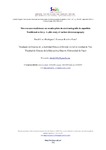Tiro con arco tradicional: un estudio piloto de electromiografía de superficie

Use este enlace para citar
http://hdl.handle.net/2183/23914
Excepto si se señala otra cosa, la licencia del ítem se describe como Atribución-NoComercial-SinDerivadas 4.0 España
Colecciones
Metadatos
Mostrar el registro completo del ítemTítulo
Tiro con arco tradicional: un estudio piloto de electromiografía de superficieTítulo(s) alternativo(s)
Traditional archery: A pilot study of surface electromyographyFecha
2019Cita bibliográfica
Lima Rodríguez, D., & Ramírez Farto, E. (2019). Tiro con arco tradicional: un estudio piloto de electromiografía de superficie. Sportis. Scientific Journal of School Sport, Physical Education and Psychomotricity, 5(3), 392-407. https://doi.org/10.17979/sportis.2019.5.3.4595
Resumen
[Resumen] El tiro con arco siempre ha sido un deporte minoritario, por lo que es un deporte poco investigado. El objetivo de este estudio piloto ha sido determinar la importancia del bíceps braquial del brazo de cuerda, porción lateral del tríceps braquial del brazo de cuerda, recto abdominal y erector spinae en su porción lumbar durante la acción técnica de tiro con arco en las divisiones de arco longbow y arco instintivo. Se análizó mediante electromiografía de superficie la activación muscular del bíceps braquial del brazo de cuerda, porción lateral del tríceps braquial del brazo de cuerda, recto abdominal y erector spinae en su porción lumbar el disparo de dos flechas a seis participantes. Los resultados apuntan a un mismo patrón de activación máxima y activación absoluta en cuatro de los y las seis participantes con mayor nivel de experiencia y rendimiento técnico y mejor adaptabilidad al propio material de entrenamiento. Los dos participantes con diferente patrón de activación máxima y activación absoluta, presentan dichos patrones similares entre ellos. Siendo los resultados de este estudio no aptos para la generalización, parece ser necesaria una mayor implicación de la porción lateral del tríceps braquial del brazo de cuerda respecto al bíceps braquial del brazo de cuerda. Pese a no haber sido posible comparar la implicación del recto abdominal con la implicación del erector spinae, la implicación máxima y absoluta del erector spinae puede tener influencia en la adopción de una postura poco estable durante la acción técnica de disparo de una flecha [Abstract] Archery has always been a minority sport, therefore is a little investigated sport. The
archery technique depends on the postural control, which is determinated by the muscular
actividy, among others. Some authors have studied the importance of the musculature
involved.
The aim was to determinate the importance of brachial biceps of the draw arm, lateral
portion of the brachial triceps of the drow arm, anterior abdominal and lumbar portion of
erector spinae during the technic action of archery in the divisions of longbow and instictive
bow. Brachial biceps of the draw arm, lateral portion of the brachial triceps of the drow arm,
anterior abdominal and lumbar portion of erector spinae of six archers were analised by
surface electromyography.
The results of the study reflects a similar pattern of maxim activation is appreciated as
on the absolute activation in four of the six archers with higher level of experience and performance and better adaptability to the personal training bow. Both the archers with
different pattern of maxim and absolute activation, have similar patterns between them. Being
the results of the study non suitables to the generalization, a higher implication of lateral
portion of the brachial triceps of the drow arm is more necessary than the brachial biceps of
the draw arm. In spite of the fact that it is not possible to compare the implication of the
anterior abdominal with the activation of the lumbar portion of erector spinae, the maxim and
absolute implication of the erector spinae may have influence in a inestable body posture
during the archery technic. More investigation is needed to go deeper in these contents
Palabras clave
Tiro con arco
Electromiografía
EMGs
Activación muscular
Archery
Electromyography
Muscular activation
Electromiografía
EMGs
Activación muscular
Archery
Electromyography
Muscular activation
Versión del editor
Derechos
Atribución-NoComercial-SinDerivadas 4.0 España
ISSN
2386-8333






